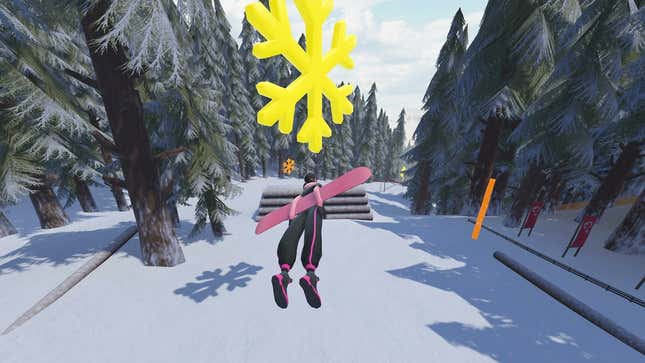I don’t think I will ever get over the death of SSX. While EA’s extreme snowboarding series isn’t officially in the ground, there hasn’t been an entry since 2012. Yet the franchise still looms large in many gamers’ minds, including mine. That is especially true of 2001’s SSX Tricky, an arcadey snowboarding game dripping with style that has never been matched, even though many have tried and failed. However, the demo for new indie game Tricky Madness has given me hope that maybe, just maybe, somebody can recapture SSX’s greatness.
Tricky Madness isn’t shy about the fact that it is an homage to SSX Tricky. If the name doesn’t give it away, then the Tricky meter and colorful snowflake icons littered across the demo’s single course sure will. That isn’t, strictly speaking, a problem, and if you’re as big a fan of SSX as me, then the overt homage is exactly what pulled you in in the first place. But it’s a bold move to take so much directly from your inspiration when you might not live up to it.
The demo, now available on Steam, gives you access to a single character on a single course. You can try your hand at a time trial or a trick competition, in the same way that SSX Tricky offered races and freestyle competitions. The course currently available is a simple snowy track down a mountain surrounded by large trees and populated with jumps and rails, very much like an early track you might race down in SSX or SSX Tricky. The similarities are so strong that immediately upon starting my first run down the course, I was struck by how much my muscle memory took over.

Switching between the Tricky Madness demo and SSX Tricky, I quickly confirmed a few things that my muscle memory had suspected. Tricky Madness is a much faster game, not in the speed at which you go down the mountain but in the speed at which you pull off tricks. Doing spins and flips feels incredibly fast-paced, which I only had a problem with when attempting the game’s equivalent of Uber tricks (which are just called Uber tricks here as well). The issue is that in some ways, performing these special tricks currently feels too easy, whereas the slower pace of tricks in SSX Tricky made Uber tricks feel like a risky endeavor.
Furthermore, I can’t get over Tricky Madness’ current steering controls, which are mapped to the left stick. Once you press the A button on an Xbox controller to prepare for a jump, you can’t steer but instead must prepare the direction you will spin in the air by pressing on the d-pad. Switching on the fly between the left stick and d-pad when going from steering to trick preparation is a little cumbersome at the moment, and I yearn for the ability to both steer and prepare for tricks on the d-pad like in SSX Tricky. Therein lies the biggest problem of Tricky Madness: the game feels so much like SSX Tricky that those moments where it deviates from its inspiration become unnerving. But again, this is just a demo and these things are very much in an early stage of development.
The more time I spent with Tricky Madness, the more I appreciated its clear understanding of and love for SSX. While the game’s art isn’t quite as poppy as that of its inspiration, the demo’s singular course still gives you a sense that it would feel right at home amongst SSX courses. That feeling grows even stronger as you poke at the edges of the course in search of secret routes. I was glad to discover a handful of shortcuts that helped me shave seconds off my time, and even a hidden half-pipe that gave me the perfect venue to pull off a series of tricks in seamless succession.
Tricky Madness doesn’t have a release date yet but the full version promises eight full courses and characters (who will be voiced and have unique tricks), a campaign and free-roam mode, and a voiced DJ to fully evoke the SSX Tricky experience. After my time with the limited demo, I can’t definitively say if Tricky Madness is the SSX successor we’ve all been waiting for, but I can say that it has given me hope it will earn that title.
.


